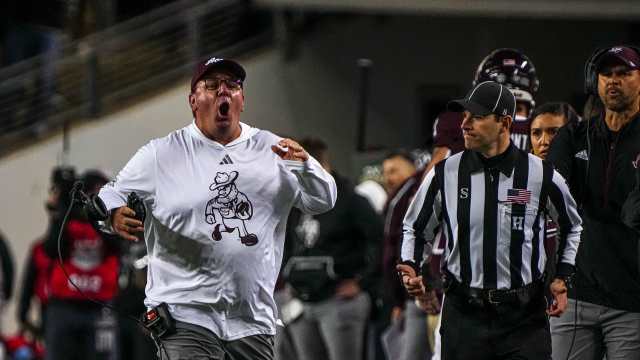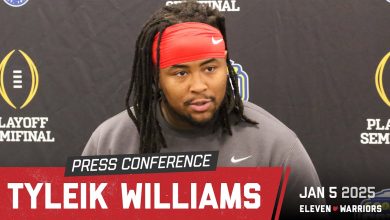Mike Elko Doesn’t Hold Back on Transfer Portal Timing: “It Doesn’t Make Sense”.

Mike Elko, the head coach of Texas A&M, has become a vocal critic of certain aspects of the modern college football landscape, particularly the timing of the NCAA’s transfer portal. Elko’s comments, including his assertion that the timing “doesn’t make sense,” reflect broader concerns within the coaching community about how the transfer portal has disrupted roster management, team-building, and the overall structure of college football. As the transfer portal system continues to evolve, many coaches, including Elko, are grappling with the challenges of a system that seems to favor immediate player mobility, often at the expense of long-term program stability.
In this piece, we’ll break down the key issues Elko raised about the timing of the transfer portal, why he believes it’s problematic, and how it could impact the future of college football.
The Basics of the Transfer Portal
The NCAA’s transfer portal was introduced in 2018 as part of a broader effort to make college athletics more athlete-friendly. The portal gives players the ability to transfer between schools without requiring them to sit out a season, which was the previous rule. Before the portal’s creation, athletes who transferred were subject to a year-long waiting period before being eligible to play for their new team.
The portal allowed players to declare their intent to transfer, which in turn notified the original program of their decision. Once in the portal, players are free to explore other opportunities, whether that’s moving to a more competitive program, seeking more playing time, or simply finding a better fit for their needs. While the system is seen as empowering for athletes, it has introduced several challenges for coaches and programs, particularly regarding the timing of when players can enter the portal and how that timing impacts their ability to plan and build teams effectively.
Elko’s Frustration: The Timing “Doesn’t Make Sense”
Mike Elko’s frustration with the transfer portal isn’t about the system in general, but about when it allows players to enter the portal. According to Elko, the timing doesn’t align well with the natural rhythms of college football, and this creates significant challenges for coaches who rely on roster stability and long-term team development.
The transfer portal opens during certain windows throughout the year, with the most notable ones being after the regular season ends and again following spring practice. For Elko, the spring transfer window — which typically opens in late April or early May — is particularly problematic. It’s a time when coaches are finalizing their rosters and preparing for the upcoming season. Players, after participating in spring practices, may decide to transfer at the last minute, leaving coaches scrambling to fill gaps in their rosters.
Elko points out that this timing doesn’t make sense because it disrupts the cohesion and continuity that coaches spend the entire offseason developing. Spring practice is a crucial period for coaches to assess their roster, make adjustments, and build a cohesive unit for the fall. If players decide to transfer immediately after spring, it can leave coaches without enough time to recruit new players, forcing them to adjust their game plans and strategies on the fly.
Additionally, Elko has highlighted how this timing often undermines the development of younger players. Coaches often use spring ball to give younger athletes more reps and assess their readiness for the upcoming season. However, if key players enter the portal after spring, it can leave a huge void in the lineup and leave coaches scrambling to fill those roles.
The Disruption to Roster Management
Elko’s frustration centers around the fact that the transfer portal’s timing disrupts the traditional process of roster management in college football. Historically, coaches would spend a significant amount of time during the offseason developing their rosters and making sure that they had the right mix of veteran and younger players. This process often involves identifying potential weaknesses, addressing depth issues, and working with players to build team chemistry.
However, the unpredictability of the transfer portal creates a constant state of flux for college football teams. After the spring practices, coaches expect to have a clear understanding of their roster, but when key players leave unexpectedly, it puts teams in a difficult position. Elko and other coaches have noted that this unpredictability makes it more difficult to plan for the future, as the roster could change at any time.
Furthermore, late transfers often put teams in a situation where they must recruit players quickly, which doesn’t always lead to the best outcomes. Rushed decisions can result in a program bringing in players who may not be the best fit, just to fill a spot. This leads to poor team cohesion and can ultimately impact a program’s performance on the field.
A Lack of Stability and Continuity
One of the most significant challenges Elko sees with the timing of the transfer portal is its impact on the stability and continuity of college football programs. Coaches, especially those leading programs at major universities, rely on a stable roster to build team culture, develop leadership, and implement long-term strategies.
When players transfer late in the offseason, it undermines the ability of coaches to maintain this stability. College football programs are built on continuity — players spend several years at a program, and in return, they grow with the team. The transfer portal erodes this continuity because players are increasingly leaving programs at critical moments, like after spring practice, when teams are already preparing for the upcoming season.
This lack of stability can be damaging to team culture. When players transfer out of the program, it can lead to a loss of experienced leadership and valuable veterans. Young players often rely on older teammates to guide them, and when these veterans leave, it creates a leadership void that can affect the development of younger athletes. Moreover, the emotional toll of seeing teammates leave — sometimes unexpectedly — can create a fractured atmosphere within the team.
The Recruiting Nightmare
Elko is also concerned that the timing of the transfer portal creates a recruiting nightmare for college football programs. Recruiting is already a highly demanding and time-sensitive process. Coaches spend years scouting high school athletes, trying to identify the best talent to build their teams. However, with the transfer portal in play, coaches must now juggle traditional recruiting efforts with the need to evaluate and recruit players who may be transferring.
For programs with limited resources, this presents a significant challenge. Smaller schools that don’t have the same level of support or scouting infrastructure as larger programs may find it difficult to compete in the transfer portal. Additionally, because the portal allows for late transfers, coaches may be forced to recruit players who are already well-established but who may not fit into the team’s long-term vision or culture.
This added layer of recruitment doesn’t only affect schools with fewer resources; it complicates things for even the largest programs. As coaches try to balance high school recruiting with portal recruitment, they are constantly caught in a reactive mode, dealing with transfers as they happen rather than having full control over their roster development.
Elko’s Call for Change
Elko’s frustration isn’t just a complaint; it’s a call for change. He isn’t necessarily advocating for the elimination of the transfer portal itself, as he recognizes the value in giving athletes the ability to move freely between programs. However, he is calling for a rethinking of the timing and structure of the portal to ensure that it doesn’t undermine the fabric of college football.
One potential solution is to modify the transfer windows so that they align more closely with the natural flow of the offseason. For example, having more structured windows for transfers that occur earlier in the offseason — prior to spring practice or immediately following the season — would give coaches more time to assess their rosters and prepare for the upcoming year. Limiting transfers to certain periods would give coaches more stability and allow them to focus on building their teams without the constant fear of losing players at inopportune times.
Moreover, such a system would allow coaches to focus on both high school recruits and transfer portal players without the overwhelming pressure of making rushed decisions. By giving both sides of the recruiting process more time and structure, the overall quality of teams could improve, and players would have more time to make thoughtful decisions about their futures.
Mike Elko’s critique of the transfer portal’s timing is a reflection of a broader concern about the future of college football. As the game continues to evolve, coaches like Elko are grappling with the challenges posed by a system that often leaves them reacting to roster changes instead of proactively managing their teams. While player freedom is crucial, Elko’s argument that the timing “doesn’t make sense” highlights a critical flaw in the current structure of the transfer portal.
Ultimately, the transfer portal system needs to be refined to balance player mobility with the stability and continuity that is vital to the success of college football programs. By adjusting the timing and structure of transfer windows, the NCAA can help restore some of the predictability and stability that coaches like Elko need to build successful, competitive teams. The solution lies in creating a system that supports both players’ rights and the long-term health of college football, ensuring that the sport can continue to thrive in the future.









